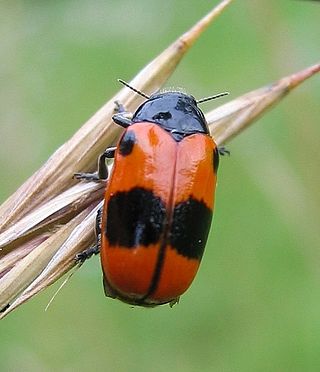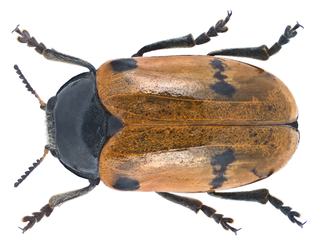
The Palearctic or Palaearctic is the largest of the eight biogeographic realms of the Earth. It stretches across all of Eurasia north of the foothills of the Himalayas, and North Africa.

Wolf spiders are members of the family Lycosidae. They are robust and agile hunters with excellent eyesight. They live mostly in solitude, hunt alone, and usually do not spin webs. Some are opportunistic hunters, pouncing upon prey as they find it or chasing it over short distances; others wait for passing prey in or near the mouth of a burrow.

Huntsman spiders, members of the family Sparassidae, are known by this name because of their speed and mode of hunting. They are also called giant crab spiders because of their size and appearance. Larger species sometimes are referred to as wood spiders, because of their preference for woody places. In southern Africa the genus Palystes are known as rain spiders or lizard-eating spiders. Commonly, they are confused with baboon spiders from the Mygalomorphae infraorder, which are not closely related.

Theridiidae, also known as the tangle-web spiders, cobweb spiders and comb-footed spiders, is a large family of araneomorph spiders first described by Carl Jakob Sundevall in 1833. This diverse, globally distributed family includes over 3,000 species in 124 genera, and is the most common arthropod found in human dwellings throughout the world.

The Pholcidae are a family of araneomorph spiders. The family contains more than 1,800 individual species of pholcids, including those commonly known as cellar spider, daddy long-legs spider, carpenter spider, daddy long-legger, vibrating spider, gyrating spider, long daddy, and skull spider. The family, first described by Carl Ludwig Koch in 1850, is divided into 94 genera.

Orb-weaver spiders are members of the spider family Araneidae. They are the most common group of builders of spiral wheel-shaped webs often found in gardens, fields, and forests. The English word "orb" can mean "circular", hence the English name of the group. Araneids have eight similar eyes, hairy or spiny legs, and no stridulating organs.

Limonium is a genus of about 600 flowering plant species. Members are also known as sea-lavender, statice, caspia or marsh-rosemary. Despite their common names, species are not related to the lavenders or to rosemary. They are instead in Plumbaginaceae, the plumbago or leadwort family. The generic name is from the Latin līmōnion, used by Pliny for a wild plant and is ultimately derived from the Ancient Greek leimon.

Acrididae, commonly called short-horned grasshoppers, are the predominant family of grasshoppers, comprising some 10,000 of the 11,000 species of the entire suborder Caelifera. The Acrididae are best known because all locusts are of the Acrididae. The subfamily Oedipodinae is sometimes classified as a distinct family Oedipodidae in the superfamily Acridoidea. Acrididae grasshoppers are characterized by relatively short and stout antennae, and tympana on the side of the first abdominal segment.

King's Wood and Urchin Wood SSSI is a 128.1 hectare biological Site of Special Scientific Interest near the villages of Cleeve and Congresbury, North Somerset, notified in 1990.

The Central Asian red deer, also known as the Tarim red deer, is a deer species native to Central Asia, where it used to be widely distributed, but is scattered today with small population units in several countries. It has been listed as Least Concern on the IUCN Red List since 2017. It was first described in the mid-19th century.

The Clytrini are a tribe within the leaf beetle subfamily Cryptocephalinae, though historically they were often treated as a distinct subfamily, Clytrinae. As the other Cryptocephalinae, they belong to the group of case-bearing leaf beetles known as Camptosomata.

Clytra quadripunctata is a species of leaf beetle in the subfamily Cryptocephalinae. Its common name is Four spotted leaf beetle.

Clytra rotundata is a species of leaf beetle in the subfamily Cryptocephalinae, that is native to Cyprus.

Clytra atraphaxidis is a species of leaf beetles in the subfamily Cryptocephalinae. It can be found in Southern Europe, Asia Minor, Central Asia, Mongolia and Korea.
Clytra binominata is a species of leaf beetles in the subfamily Cryptocephalinae. It can be found in Turkey and Greece.
Clytra nigrocincta is a species of leaf beetles in the subfamily Cryptocephalinae, that can be found in eastern Turkey, Syria, Iraq, the Caucasus and in the northern part of Iran.

Clytra novempunctata is a species of leaf beetles in the subfamily Cryptocephalinae. It can be found in Romania on the Balkan Peninsula, in southern Ukraine, the Russian Caucasus, Asia Minor and Central Asia. It has also been recorded in Italy, on the island of Sicily.
Clytra bodemeyeri is a species of leaf beetles in the subfamily Cryptocephalinae that can be found in Asia Minor and Iraq.
Clytra aliena is a species of leaf beetles from the subfamily Cryptocephalinae, that is native to Turkey.

Clytra is a genus of short-horned leaf beetles belonging to the family Chrysomelidae, subfamily Cryptocephalinae.















